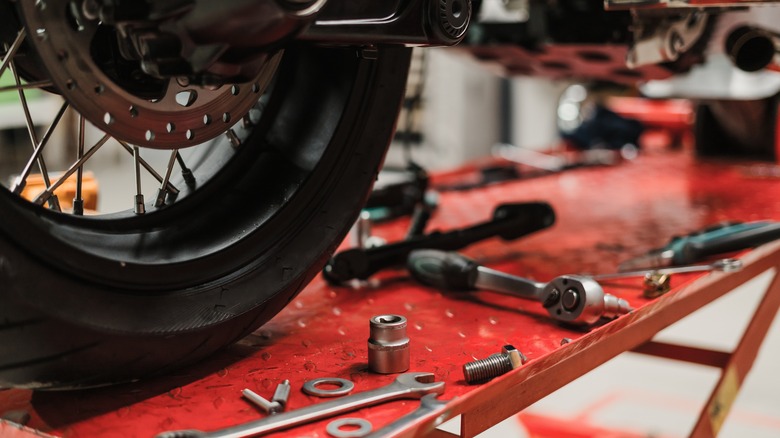
Arthur Bargan/Shutterstock
Motorcycles are more vulnerable than cars to other road users, and significantly more affected by substandard roads and bad weather conditions. Mechanical failures and poor upkeep are also more likely to have catastrophic results than with other modes of transport. It is therefore essential to keep our bikes properly serviced and maintained. While technical work is best left to skilled professionals, every biker should be able to perform basic maintenance to ensure their bike is safe and road-ready, and keep a selection of essential tools at home for this purpose.
Typical home motorcycle maintenance starts from the ground up. Keeping tire pressures topped up and the chain clean and well-lubricated are two fundamental tasks all motorcycle owners must regularly perform. Beyond this, it is useful to know how to change, charge, and tender a battery, replace an air filter, perform an oil change, replace bulbs, top up coolant and brake fluid, and replace spark plugs, among other things. Regular maintenance will not only help provide peace of mind, but also help you better understand your vehicle and improve your ability to detect faults, preventing issues further down the road.
A solid maintenance regimen, combined with a good general knowledge of how your motorcycle functions, will help keep you safer on the road and save you money on labor costs. The following tools and tool combinations are essential items for every motorcyclist’s garage, whether you’re a skilled mechanic or simply performing basic motorcycle maintenance at home.
Compatible motorcycle stand
Now that most modern motorcycles don’t feature a center stand as standard, an external stand is usually an essential addition to your garage. A stand is necessary to raise your wheel off the ground for chain oiling and cleaning, tire checks and repair, working on the brakes, wheel removal, and to hold your bike upright for oil changes and other maintenance.
A paddock stand has become the most common option, as most motorcycles include spools on the rear swingarm into which the stand engages. These can take a little getting used to when using them on your own, as the bike should be held level before the stand can be properly aligned. A useful tip is to keep a wooden wedge handy to place under the kickstand, holding the bike upright while you line up the paddock stand’s forks. Another paddock stand can be used to lift the front wheel, if necessary, while the rear is raised, at the steering stem or beneath the forks.
For motorcycles that don’t feature spools on the swingarm, such as most dirt bikes, a panel stand or scissor lift is your best option. A panel stand is a square metal prop placed beneath the bash plate to raise your motorcycle and hold it level, while a scissor lift allows you to jack up your bike to the desired height. The latter can also be used on other types of motorcycles, including sport bikes and cruisers, and are a useful alternative to paddock stands, especially when both wheels need to be elevated.
Workshop mat
Create a dedicated workspace for your motorcycle with a workshop mat. Not only will it add a pleasing aesthetic to your garage, but it comes with several practical benefits as well.
A workshop mat keeps your garage floor free of kick stand gouges as you repeatedly wheel your motorcycle in and out of its parking space, and provides a scratch-free surface where you can lay down tools, parts, and manuals while you work. It also serves to catch oil drips and other spills, and is easily cleaned afterward.
A mat’s non-slip surface makes sure your bike is kept steady as you work, and provides a firm footing for paddock stands and scissor lifts. Its cushioning protects your knees while you work underneath your motorcycle and saves tires from wear while the bike is stationary for long periods. If you live in a seasonally cold location, a workshop mat insulates tires against damage from cold flooring while storing your bike for winter.
Steel ruler

Brunohitam/Shutterstock
Sometimes the most basic of tools are invaluable, and a simple steel ruler should be included in every comprehensive motorcycle tool set. Your motorcycle should always be finely balanced and evenly adjusted, and accurate measurements assure correct adjustment and peace of mind. In my case, they appeal to my annoyingly meticulous nature, too.
A ruler can be used for checking drive chain tension, in relation to the swingarm. Your motorcycle owner’s manual should give you the measurement for the maximum amount of slack. Similarly, it can be used to check and adjust your rear wheel alignment by measuring your chain adjustment blocks, relative to the swingarm.
A ruler can also be used for accurately checking preload adjustment on the rear shock and front shock lengths relative to the top yoke. It can also be used in the workshop for quickly checking bolt sizes and other peripherals, and on the bike itself for checking the even alignment of accessories such as luggage brackets and auxiliary lights.
Tire pressure gauge
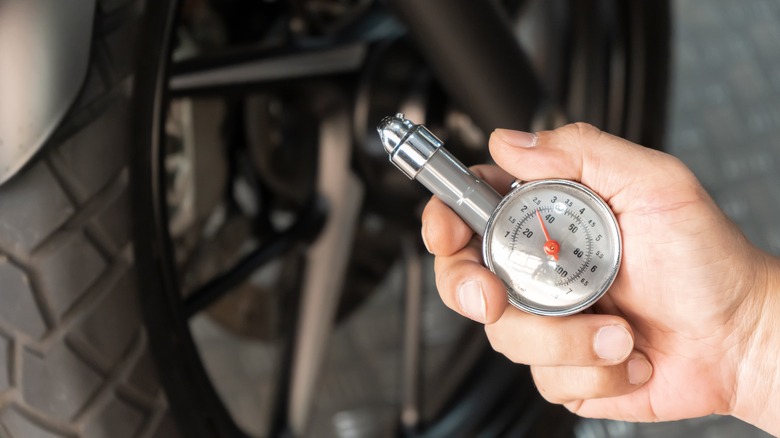
kasarp studio/Shutterstock
Maintaining the optimal tire pressure is essential to safe riding and optimizing your bike’s performance. Unlike with four-wheeled vehicles, motorcycle tire pressures must be altered to suit various conditions, including the ambient temperature and when carrying additional load or a pillion passenger. A tire pressure gauge is an affordable and useful tool to keep in your garage, and should be used regularly, especially after long periods of inactivity and before departing on long rides. You should refer to your motorcycle owner’s manual for the manufacturer’s suggested front and rear tire pressures, or these are sometimes stated upon the bike’s frame.
Alternatively, you can use tire pressure monitoring valve caps. These replace your regular valve caps by screwing onto your tires’ valve stems, and provide feedback either with a colored indicator to tell you that your pressure is normal, or you can choose the more technical tire pressure monitoring system (TPMS) option with Bluetooth functionality. These are manufactured by brands including FOBO, Sykik, and Leepee, and relay tire pressure data and issue alerts to your phone or smartwatch via a companion app.
Tire compressor
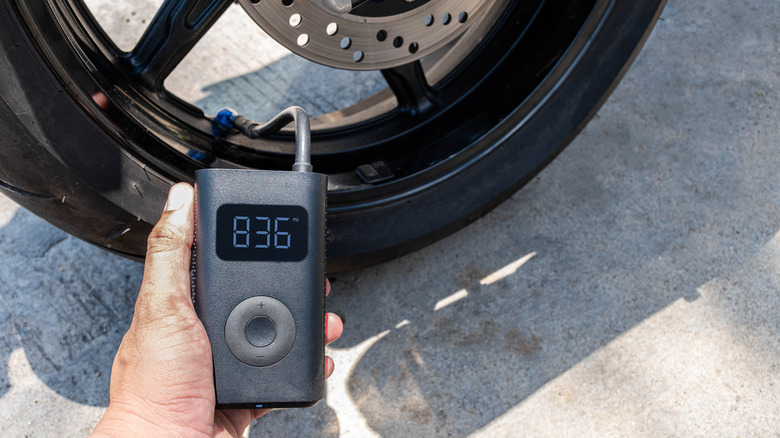
Cobalt S-Elinoi/Shutterstock
A tire compressor is a useful tool to own whether you favor two wheels or four. However, as we previously mentioned, a motorcycle’s tire pressure must be carefully monitored and altered, making this an essential addition to every motorcyclist’s garage. There are many different types of tire compressor, but for the sake of convenience, portable units make the most sense. These are relatively inexpensive, powerful enough, and can work with a choice of power sources, including vehicle battery, 12-volt cigarette lighter, and regular wall outlets.
As an alternative, some handheld options have an integral battery, are compact, and charge via USB. These affordable gadgets easily fit in your top box to take on the road and also double as a tire pressure gauge, making them an essential item whether you are at home or away on a trip. It’s also a good idea to keep a tubeless tire repair kit or tire spoons and spare inner tubes handy to accompany your mobile tire compressor, so that you are fully equipped to deal with a flat, especially on longer rides.
Chain maintenance kit
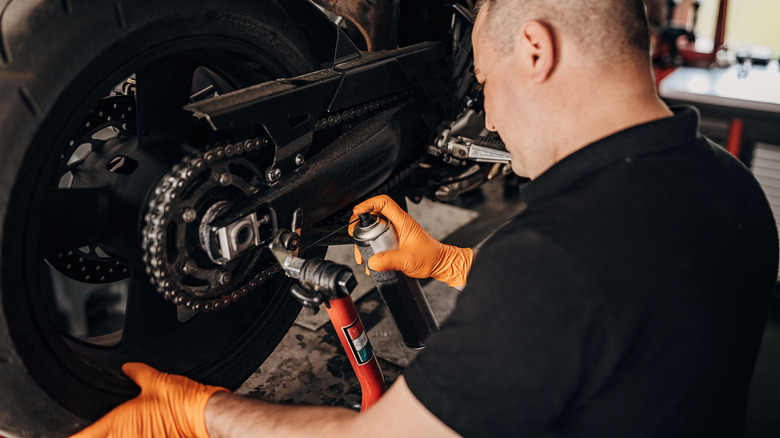
South_agency/Getty Images
Chain maintenance is essential to reduce wear on sprockets and to keep your chain in the best working condition. A decent chain brush,a quality chain oil or aerosol chain lube, and chain cleaner are essential for cleaning and lubricating your motorcycle chain. This should be performed regularly at intervals of between 300-600 road miles, or more frequently if you ride off-road. If you regularly go on long rides, it’s a good habit to lube your chain after each trip, while the chain is still warm and ready for the next adventure.
Lube your chain with the bike on a stand, switched off, and set to neutral. Rotate the rear wheel manually as you clean and oil the chain, to avoid trapping fingers or producing excessive splatter. Once complete, simply wipe off any excess residue on a rag and lower the bike from its stand.
A chain breaker and rivet kit, can also be a useful addition to your tool arsenal, for repairing and altering chains, especially if you subject your bike to harsh punishment riding off-road or for motorsports. With that said, by regularly inspecting the chain and sprocket each time you perform chain maintenance, you can pre-empt breakages by replacing them at the first signs of wear.
Tire tread gauge
Your tires are the final frontier between you and the hard surface and one of the most important parts of the motorcycle to keep in check. How long they last depends on the type of tire compound, your riding habits, and the quality of the tires you use, and it is up to you to ensure that they are roadworthy, to provide the traction you need before you head out.
The minimum legal tread depth in the United States is between 1/32-inch and 2/32-inch (0.8-1.6 millimeter) and this varies in other countries. While many tire manufacturers add indicators to let you know that your tires have reached their usable limit, using a tread gauge is the best way to make sure that your tires meet regulations and you are safe to ride. A quality digital tire tread gauge is fairly inexpensive and highly accurate. When using one, always check the depth at the center of the tire tread, as this is where most wear occurs.
Regularly checking your tires’ tread depth also encourages you to inspect the tires for defects at the same time. Look for bulges, blisters, and tears in the tire wall and for foreign objects that may have penetrated the tire. While quality motorcycle tires are certainly not cheap, it is essential to consider replacing any tire that may be defective, or showing excessive signs of wear.
Oil drain pan and funnel
Motor oil is the lifeblood of your motorcycle and it should be closely monitored and scheduled for regular replacement. Once you are familiar with your ideal brand, type, and the optimal viscosity of your oil (as recommended in your motorcycle owner’s manual), there’s nothing stopping you from changing your oil in your own garage.
Performing your own oil change is relatively easy, and more convenient and less costly than taking your motorcycle to a service center. While any large enough receptacle will do the trick to catch the oil as you drain the sump, a purpose-built oil drain pan is a far better prospect for its convenience, cleanliness, and ease of disposal.
The best drain pans lie flat beneath your motorcycle’s oil sump plug, with a concave side panel, so when the sump plug is removed, the oil collects and drains into the pan’s reservoir. Once complete, simply plug the side panel, wipe up any excess residue, and the old oil can then be removed for safe disposal. Once your sump plug is replaced, a properly-sized funnel is essential for replenishing your bike’s oil with clean, fresh lubricant.
Battery charger and tender
For those of us that don’t live in the tropics, riding can be a seasonal pursuit, and your bike may be stored for a long period over the winter months without being used. When you do finally retrieve your bike from hibernation, you need it to be ready to roll, and diligent battery maintenance will help ensure it fires up at the first push of the starter button.
A battery tender, or battery maintainer, is essential to maintaining your battery’s health when it is out of service. Simply connect it to your positive and negative battery terminals and it provides a trickle charge of less than two amps, as needed, to keep the battery ticking over. It should be left in this state as long as your bike is in storage, up until the day that you are ready to reconnect the battery to your motorcycle and start riding again.
Conversely, there will inevitably be instances when your motorcycle battery runs completely flat, or is significantly depleted of power. In this case, a battery charger is a useful tool to have in your garage to rapidly recharge your battery and restore it to its fully-functioning state. If you are concerned about losing power while out riding, there are many compact options available that will easily fit into your motorcycle luggage.
Comprehensive mechanic’s tool kit
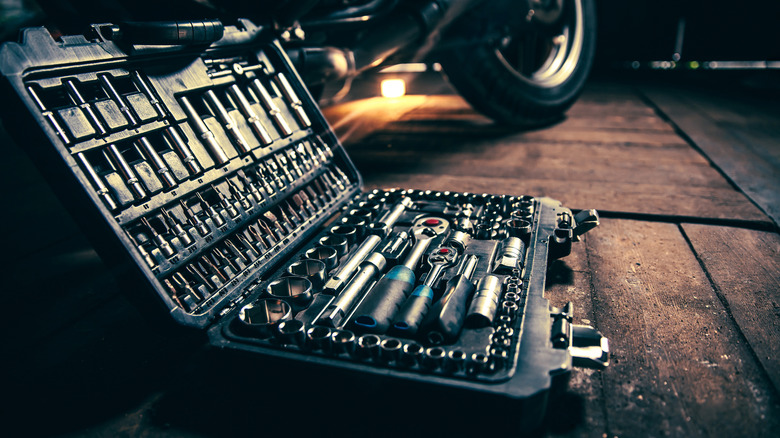
Vlad Linev/Shutterstock
Our last suggestion is perhaps an obvious one, but is arguably the most important addition to every motorcycle owner’s garage. A comprehensive set of good quality tools is something no mechanic should be without. A decent set should last you for years and will make sure that you are fully prepared for every eventuality when it comes to servicing and maintaining your prized two-wheeler.
Your tool kit should include a torque wrench set for accurately screwing fastenings to the correct torque. These are especially useful for parts susceptible to excessive vibration including axle bolts, brake caliper bolts, luggage brackets, and many others. A breaker bar is also recommended to free fastenings that have become stuck fast. Your home tool kit can be supplemented with a compact socket and ratchet set that fits in a luggage compartment, for performing maintenance and tightening loose fastenings while on the road.
The mechanic’s tool kit should also include a wrench set, for accessing bolts and fastenings that cannot be reached with a ratchet and socket, as well as screwdriver and hex key sets, as many motorcycle components and accessories are also secured with hex key and flat-head or Phillips-head bolts. It is worth noting that motorcycles and accessories use either imperial or metric measurements, depending on their manufacturer or country of origin, so ideally your tool kit should cater to both standards.